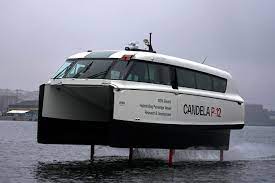The vessel is designed to carry 30 passengers at a maximum speed of 30 knots (56 kph or 35 mph) — considerably faster than other electric passenger ferries. It achieves this with carbon fiber hydrofoil wings that lift the boat out of the water, reducing drag.
Candela says its technology reduces the energy per passenger-kilometer by 95% compared with the diesel ships that are currently transporting passengers across the picturesque Stockholm archipelago, which is made up of tens of thousands of islands and skerries stretching out into the Baltic Sea.
An added benefit is that the vessel is exempt from the 12-knot speed limit in Stockholm because it leaves no wake — waves made by a boat’s displacement through water that increase with speed and could swamp other vessels or erode the shoreline.
The P-12 is still in testing but is set to enter service in July between the Stockholm suburb of Ekero and the city center as part of a nine-month pilot project. The ferry will cut the travel time from Ekero by conventional public transport from 55 minutes to 25 minutes.
The company wants to build on lessons learned from the launch of its smaller electric hydrofoil leisure boat. Onboard, engineers are fine-tuning the hydrofoils, which are regulated by a computer 100 times per second to compensate for the sea state and negate the effects of any waves. The vessel can operate in waves of up two meters (6.5 feet).
Candela hopes that as well as Stockholm, cities like San Francisco, New York and Venice will lead the electrification of waterborne public transport.
Gustav Hemming, Vice President of the Regional Executive Board in Stockholm, said the Swedish capital is on board.
“The ambition is, for the Stockholm region, to expand public transport on water, because we think that is one of the keys to make public transport more attractive,” he said.
There were around 6.2 million public transport boat journeys in the Stockholm region in 2022, and while boat traffic remains a small part of the entire public transit system, it is the fastest-growing mode of public transport after the COVID-19 pandemic.
“Our roads are congested and building new ones is very expensive and not very environmentally friendly,” Hemming said, looking out onto the open waters of Stockholm on a cold autumnal day. “But here we have our traditional infrastructure. There is no congestion on the water.”
The use of hydrofoils to raise a vessel out of the water to reduce drag is not new. Ship designers have experimented with the technology for more than a century, but costs and maintenance issues had prevented its widespread adoption. However, new lightweight carbon fiber material saw the technology make a comeback in elite sailing, and with efficient electric motors and high costs for traditional fuels it’s getting a second birth in the public transport sector, too.
“We know that marine vessels are often energy-hungry, and the limited energy density of today’s batteries will be a barrier for electrification of a marine fleet,” said Arash Eslamdoost, associate professor of applied hydrodynamics at the Chalmers University of Technology in Gothenburg. “Here is where foiling steps in as a radical solution for taking the most out of the limited onboard electric power.”
Globally, several hydrofoil electric passenger ferries are under design or actively being developed. In the U.K., Artemis Technologies has announced plans for a fully electric hydrofoil ferry to operate in Northern Ireland between Belfast and nearby Bangor, possibly as early as next year.
Robin Cook from the Swedish Transport Agency says the maritime industry is ripe for change, especially for short-distance connections. But he stressed that public infrastructure must keep up with the latest developments and even encourage this through incentives.
“One important part of the electrification is when the ships connect to the ports through the onshore power supply,” he said. “And here the harbors play a very important role to make sure that the infrastructure is in place for these connections.”








